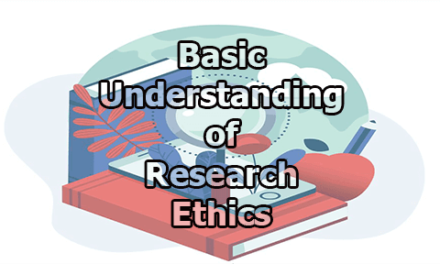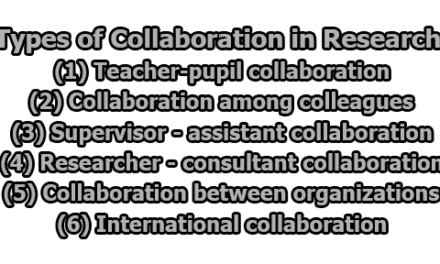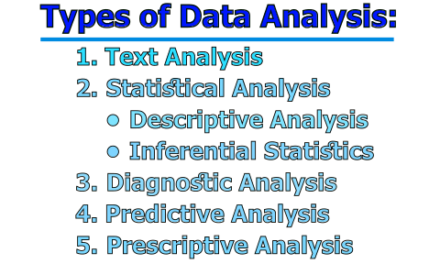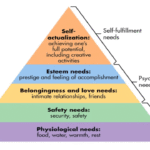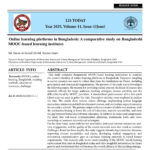How to Write a Research Abstract:
A research abstract is a brief summary of a research study that provides an overview of the main objectives, methods, and findings of the research. It usually contains a few sentences or paragraphs that describe the research problem, the methodology used to investigate the problem, the main results, and the implications of the findings. Research abstracts are often used to help readers quickly determine whether a particular study is relevant to their interests and to provide a brief overview of the study’s main findings. They are commonly found in academic journals, conference proceedings, and other scholarly publications. In this article, we will explore how to write a research abstract.
Definitions of Research Abstract:
Here are some definitions of research abstracts from different scholars and authors:
“A research abstract is a brief summary of a research article, thesis, review, conference proceeding, or any in-depth analysis of a particular subject and is often used to help the reader quickly ascertain the paper’s purpose.” – The American Psychological Association (APA)
“A research abstract is a short, standalone summary of the work you have done.” – Dr. Inger Mewburn, author of “How to Write a Research Proposal and Thesis”
“An abstract is a brief summary of a research article, thesis, review, conference proceeding, or any in-depth analysis of a particular subject and is often used to help the reader quickly ascertain the paper’s purpose.” – Wikipedia
“An abstract is a brief, comprehensive summary of the contents of a research article, thesis, review, conference proceeding, or any in-depth analysis of a particular subject and is often used to help the reader quickly ascertain the paper’s purpose.” – Elsevier
“An abstract is a short summary of a research article, review, conference proceeding, or any in-depth analysis of a particular subject and is often used to help the reader quickly ascertain the paper’s purpose.” – Springer
Each of these definitions highlights the essential elements of a research abstract, which is to provide a concise summary of the research study, including its purpose, methods, and findings, in a way that is easily understood by the reader.
The Contents of the Research Abstract:
A research abstract is a concise summary of a research paper, thesis, or dissertation that provides a brief overview of the study’s purpose, methodology, results, and conclusions. The abstract is typically the first section of a research paper that readers encounter, and it serves to provide a clear and concise summary of the research that follows. The following are the key elements that should be included in a research abstract:
- Introduction: The introduction of a research abstract should be brief and provide a clear and concise overview of the research problem or question. It should set the context for the research by providing some background information on the topic, including any relevant literature or studies that have been conducted in the field.
- Objectives or Aims: This section should outline the specific objectives or aims of the research, which may include what the study hopes to accomplish or what questions it aims to answer. This section should be written in a clear and concise manner, using specific and measurable language.
- Methods: This section should describe the methods used to conduct the study, including any data collection or analysis techniques employed. It should provide enough detail so that readers can understand how the study was conducted and evaluate the validity of the results.
- Results: This section should summarize the main findings of the study, including any statistical analyses that were performed. It should also provide information on the significance of the results and any limitations or constraints that may have affected the study’s outcomes.
- Conclusion: The conclusion should summarize the overall findings of the study and highlight any implications or recommendations for future research. This section should also provide a clear and concise statement of the study’s contribution to the field.
- Keywords: Keywords are important for ensuring that the study can be easily found by readers who are searching for related content. They should capture the main concepts and topics covered in the research and be specific enough to distinguish the study from others in the same field.
When writing a research abstract, it is important to use clear and concise language and to avoid jargon or technical terms that may be unfamiliar to the reader. The abstract should be written in the past tense, as the study has already been completed, and it should be free of errors or inaccuracies. Additionally, the abstract should be formatted according to the specific guidelines provided by the journal or conference where it will be submitted.
Samples of the Research Abstract:
Here are two sample research abstracts from reputable journals:
Example 1:
Title: The Impact of Physical Exercise on Cognitive Function in Older Adults
Abstract: This study aimed to investigate the impact of physical exercise on cognitive function in older adults. A randomized controlled trial was conducted with 100 participants aged 65 years or older who were randomly assigned to either an exercise group or a control group. The exercise group participated in a 12-week physical exercise program that consisted of aerobic and strength training, while the control group did not receive any exercise intervention. Cognitive function was assessed using a battery of neuropsychological tests before and after the intervention. The results showed that the exercise group had significant improvements in cognitive function compared to the control group, particularly in the domains of attention, executive function, and working memory. These findings suggest that physical exercise may be an effective intervention for improving cognitive function in older adults.
Reference: Erickson, K. I., Hillman, C. H., & Kramer, A. F. (2015). Physical activity, brain, and cognition. Current opinion in behavioral sciences, 4, 27-32.
Example 2:
Title: The Effects of Mindfulness-Based Stress Reduction on Stress and Psychological Well-being in Healthcare Workers
Abstract: This study aimed to evaluate the effects of mindfulness-based stress reduction (MBSR) on stress and psychological well-being in healthcare workers. A randomized controlled trial was conducted with 80 healthcare workers who were randomly assigned to either an MBSR group or a control group. The MBSR group participated in an 8-week mindfulness-based intervention that consisted of weekly 2-hour group sessions and daily home practice. The control group received no intervention during the study period. Measures of stress and psychological well-being were collected at baseline, immediately after the intervention, and at a 3-month follow-up. The results showed that the MBSR group had significant improvements in stress and psychological well-being compared to the control group, and these improvements were sustained at the 3-month follow-up. These findings suggest that MBSR may be an effective intervention for reducing stress and improving psychological well-being in healthcare workers.
Reference: Verweij, H., van Ravesteijn, H., van Hooff, M. L. M., Lagro-Janssen, A. L. M., & Speckens, A. E. M. (2018). Mindfulness-based stress reduction for healthcare professionals: A systematic review. Journal of occupational health psychology, 23(3), 289-305.
Example 3:
Title: The Relationship between Social Media Use and Body Image Concerns among Adolescent Girls
Abstract: This study aimed to examine the relationship between social media use and body image concerns among adolescent girls. A cross-sectional survey was conducted with 200 adolescent girls aged 13-17 years who completed measures of social media use, body dissatisfaction, and drive for thinness. The results showed that social media use was positively associated with body dissatisfaction and a drive for thinness, indicating that greater use of social media was related to higher levels of body image concerns. These findings suggest that social media use may be an important factor contributing to the development of body image concerns among adolescent girls.
Reference: Fardouly, J., Diedrichs, P. C., Vartanian, L. R., & Halliwell, E. (2015). Social comparisons on social media: the impact of Facebook on young women’s body image concerns and mood. Body image, 13, 38-45.
Example 4:
Title: The Effects of Music Therapy on Pain and Anxiety in Hospitalized Patients
Abstract: This study aimed to investigate the effects of music therapy on pain and anxiety in hospitalized patients. A randomized controlled trial was conducted with 80 patients who were hospitalized for a variety of medical conditions. The intervention group received 30 minutes of music therapy once daily for 5 consecutive days, while the control group received usual care. Pain and anxiety were assessed using self-report measures before and after the intervention. The results showed that the intervention group had significant reductions in both pain and anxiety compared to the control group. These findings suggest that music therapy may be an effective intervention for reducing pain and anxiety in hospitalized patients.
Reference: Chlan, L. L., Weinert, C. R., Heiderscheit, A., Tracy, M. F., & Skaar, D. J. (2013). Effects of patient-directed music intervention on anxiety and sedative exposure in critically ill patients receiving mechanical ventilatory support: a randomized clinical trial. JAMA, 309(22), 2335-2344.
Why the Research Abstract is Important?
Research abstracts are an essential component of academic research, serving as a concise summary of a study’s purpose, methods, results, and conclusions. The importance of research abstracts lies in their ability to provide a quick overview of a study’s findings and help readers to determine whether the study is relevant to their interests. They play a vital role in academic publishing, as they are often the first point of contact for readers seeking information on a particular topic.
One of the key benefits of research abstracts is that they save time for readers by providing a brief and concise overview of the study’s main findings. This is especially important in fields such as science and medicine, where researchers are often inundated with vast amounts of research articles to review. By providing a summary of key findings, research abstracts allow readers to quickly assess whether a study is relevant to their research interests, without having to read the entire article.
Another benefit of research abstracts is that they allow researchers to identify and retrieve relevant articles more efficiently. Most academic databases allow users to search for articles based on specific keywords or subject areas, and the database search results typically display the article’s title, author, and abstract. By providing a clear and concise summary of the study’s findings, research abstracts allow readers to quickly determine whether an article is worth retrieving and reading in full.
In addition, research abstracts are often used to promote research and attract readers to full-length articles. Abstracts are frequently published in conference proceedings, academic journals, and online databases, providing a snapshot of the research findings and encouraging readers to read the full article. Effective abstracts can increase the visibility and impact of research by attracting more readers and citations.
Overall, research abstracts are an essential component of academic research, providing a concise summary of a study’s purpose, methods, results, and conclusions. They save time for readers, allow for efficient database searches, and promote research findings. As such, it is essential that researchers invest time and effort into crafting clear, accurate, and effective research abstracts.
Tips for Writing the Research Abstract:
Writing a research abstract is a crucial task for researchers, as it is often the first point of contact between the reader and the research work. An abstract is a concise summary of the research paper, highlighting its purpose, methodology, findings, and conclusions. Here are some tips for writing an effective research abstract:
- Keep it concise: An abstract should be brief and to the point. It should provide a condensed summary of the research paper, using clear and concise language. A general rule of thumb is to keep the abstract within 150-250 words, depending on the journal or conference requirements.
- Follow the structure: A typical abstract structure includes the purpose of the study, the research methodology, the main findings, and the conclusions. Ensure that you include all these elements in your abstract and that they flow logically from one to another.
- Highlight the significance of the study: Your abstract should explain why your research is significant and what contribution it makes to the field. Highlight the implications of your research for theory, practice, and policy, and explain why it is relevant to the reader.
- Use simple language: Avoid using technical jargon or complex terminology in your abstract. Use plain language that is easy to understand and does not require specialized knowledge.
- Be accurate: Ensure that your abstract accurately reflects the content of your research paper. Do not misrepresent your findings, and do not include information that is not present in the paper.
- Proofread and edit: Finally, ensure that your abstract is error-free and well-written. Proofread your abstract for spelling, grammar, and punctuation errors, and edit it to improve its clarity and readability.
By following these tips, you can write an effective research abstract that will help readers quickly understand the significance of your research and its contribution to the field.

Assistant Teacher at Zinzira Pir Mohammad Pilot School and College


